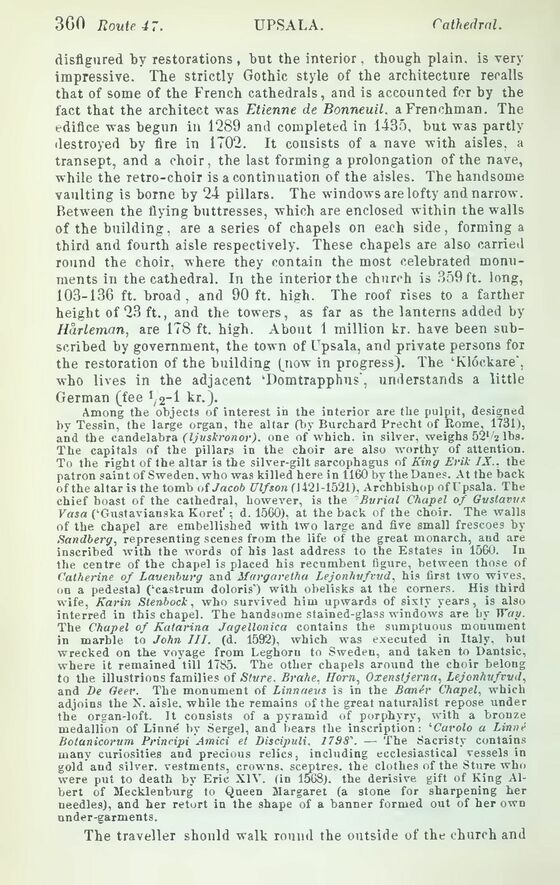
Full resolution (JPEG) - On this page / på denna sida - Sweden - Pages ...

<< prev. page << föreg. sida << >> nästa sida >> next page >>
Below is the raw OCR text
from the above scanned image.
Do you see an error? Proofread the page now!
Här nedan syns maskintolkade texten från faksimilbilden ovan.
Ser du något fel? Korrekturläs sidan nu!
This page has never been proofread. / Denna sida har aldrig korrekturlästs.
disfigured hy restorations , "but the interior , though plain, is very
impressive. The strictly Gothic style of the architecture recalls
that of some of the French cathedrals, and is accounted for by the
fact that the architect was Etienne de Bonneuil. a Frenchman. The
edifice was begun in 1289 and completed in 1435, but was partly
destroyed by fire in 1702. It consists of a nave with aisles, a
transept, and a choir, the last forming a prolongation of the nave,
while the retro-choir is a continuation of the aisles. The handsome
vaulting is borne by 24 pillars. The windows are lofty and narrow.
Between the flying buttresses, which are enclosed within the walls
of the building, are a series of chapels on each side, forming a
third and fourth aisle respectively. These chapels are also carried
round the choir, where they contain the most celebrated
monuments in the cathedral. In the interior the church is 359 ft. long,
103-136 ft. broad, and 90 ft. high. The roof rises to a farther
height of 23 ft., and the towers, as far as the lanterns added by
Hårleman, are 178 ft. high. About 1 million kr. have been
subscribed by government, the town of Upsala, and private persons for
the restoration of the building (now in progress). The ‘Klockare",
who lives in the adjacent ‘Domtrapphus", understands a little
German (fee hr.).
Among the objects of interest in the interior are the pulpit, designed
by Tessin, the large organ, the altar (by Burchard Precht of Rome, 1731),
and the candelabra (ljuskronor), one of which, in silver, weighs 52*>i lbs.
The capitals of the pillars in the choir are also worthy of attention.
To the right of the altar is the silver-gilt sarcophagus of King Erik IS., the
patron saint of Sweden, who was killed here in 1160 by the Danes. At the back
of the altar is the tomb of Jacob Ulfson (1421-1521), Archbishop of Gpsala. The
chief boast of the cathedral, however, is the Burial Chapel of Guslavus
Vasa (-Gustavianska Koret’ d. 1560), at the back of the choir. The walls
of the chapel are embellished with two large and five small frescoes by
Sandberg, representing scenes from the life of the great monarch, and are
inscribed with the words of his last address to the Estates in 1560. In
the centre of the chapel is placed his recnmbent figure, between those of
Catherine of Lauenburg and Margaretha Lejonhufvud, his first two wives,
on a pedestal (‘castrum doloris’) with obelisks at the corners. His third
wife, Karin Stenbock, who survived him upwards of sixty years, is also
interred in this chapel. The handsome stained-glass windows are by Way.
The Chapel of Katarina Jagellonica contains the sumptuous monument
in marble to John III. (d. 1592), which was executed in Italy, but
wrecked on the voyage from Leghorn to Sweden, and taken to Dantsic,
where it remained till 1785. The other chapels around the choir belong
to the illustrious families of Sture. Brahe. Horn, Oxenstjerna, Lejonhufvud,
and De Geer. The monument of Linnaeus is in the Banff Chapel, which
adjoins the X. aisle, while the remains of the great naturalist repose under
the organ-loft. It consists of a pyramid of porphyry, with a bronze
medallion of Linné by Sergei, and bears the inscription: ‘Carolo a Linnf
Botanicorum Principi Amici et Discipuli, 1798’. — The Sacristy contains
many curiosities and precious relics, including ecclesiastical vessels in
gold and silver, vestments, crowns, sceptres, the clothes of the StuTe who
were put to death by Eric XIV. (in 1568). the derisive gift of King
Albert of Mecklenburg to Queen Margaret (a stone for sharpening her
needles), and her retort in the shape of a banner formed out of her own
under-garments.
The traveller should walk round the outside of the church and
<< prev. page << föreg. sida << >> nästa sida >> next page >>